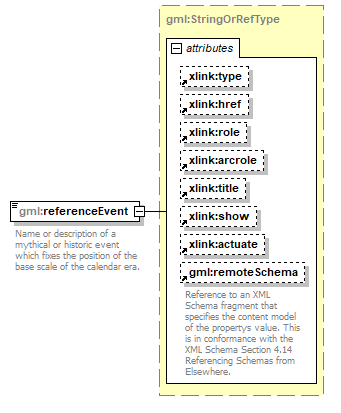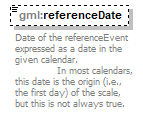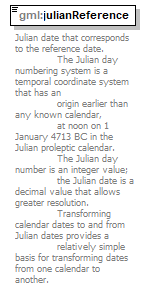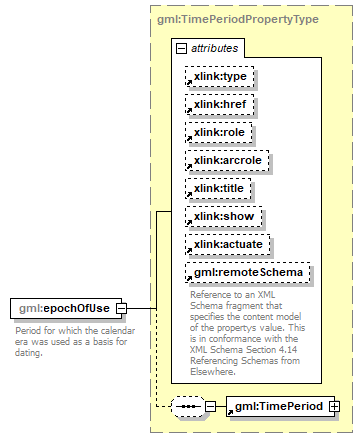| diagram |  |
||||||||||||||
| namespace | http://www.opengis.net/gml | ||||||||||||||
| type | extension of gml:DefinitionType | ||||||||||||||
| properties |
|
||||||||||||||
| children | gml:metaDataProperty gml:description gml:name gml:referenceEvent gml:referenceDate gml:julianReference gml:epochOfUse | ||||||||||||||
| used by |
|
||||||||||||||
| attributes |
|
||||||||||||||
| annotation |
|
||||||||||||||
| source | <xs:complexType name="TimeCalendarEraType"> <xs:annotation> <xs:documentation xml:lang="en">In every calendar, years are numbered relative to the date of a reference event that defines a calendar era. In this implementation, we omit the back-pointer "datingSystem".</xs:documentation> </xs:annotation> <xs:complexContent> <xs:extension base="gml:DefinitionType"> <xs:sequence> <xs:element name="referenceEvent" type="gml:StringOrRefType"> <xs:annotation> <xs:documentation>Name or description of a mythical or historic event which fixes the position of the base scale of the calendar era.</xs:documentation> </xs:annotation> </xs:element> <xs:element name="referenceDate" type="date" default="0001-01-01" minOccurs="0"> <xs:annotation> <xs:documentation>Date of the referenceEvent expressed as a date in the given calendar. In most calendars, this date is the origin (i.e., the first day) of the scale, but this is not always true.</xs:documentation> </xs:annotation> </xs:element> <xs:element name="julianReference" type="decimal"> <xs:annotation> <xs:documentation>Julian date that corresponds to the reference date. The Julian day numbering system is a temporal coordinate system that has an origin earlier than any known calendar, at noon on 1 January 4713 BC in the Julian proleptic calendar. The Julian day number is an integer value; the Julian date is a decimal value that allows greater resolution. Transforming calendar dates to and from Julian dates provides a relatively simple basis for transforming dates from one calendar to another.</xs:documentation> </xs:annotation> </xs:element> <xs:element name="epochOfUse" type="gml:TimePeriodPropertyType"> <xs:annotation> <xs:documentation>Period for which the calendar era was used as a basis for dating.</xs:documentation> </xs:annotation> </xs:element> </xs:sequence> </xs:extension> </xs:complexContent> </xs:complexType> |
element TimeCalendarEraType/referenceEvent
| diagram |  |
||||||||||||||||||||||||||||||||||||||||||||||||||||||||
| namespace | http://www.opengis.net/gml | ||||||||||||||||||||||||||||||||||||||||||||||||||||||||
| type | gml:StringOrRefType | ||||||||||||||||||||||||||||||||||||||||||||||||||||||||
| properties |
|
||||||||||||||||||||||||||||||||||||||||||||||||||||||||
| attributes |
|
||||||||||||||||||||||||||||||||||||||||||||||||||||||||
| annotation |
|
||||||||||||||||||||||||||||||||||||||||||||||||||||||||
| source | <xs:element name="referenceEvent" type="gml:StringOrRefType"> <xs:annotation> <xs:documentation>Name or description of a mythical or historic event which fixes the position of the base scale of the calendar era.</xs:documentation> </xs:annotation> </xs:element> |
element TimeCalendarEraType/referenceDate
| diagram |  |
||||||||||
| namespace | http://www.opengis.net/gml | ||||||||||
| type | xs:date | ||||||||||
| properties |
|
||||||||||
| annotation |
|
||||||||||
| source | <xs:element name="referenceDate" type="date" default="0001-01-01" minOccurs="0"> <xs:annotation> <xs:documentation>Date of the referenceEvent expressed as a date in the given calendar. In most calendars, this date is the origin (i.e., the first day) of the scale, but this is not always true.</xs:documentation> </xs:annotation> </xs:element> |
element TimeCalendarEraType/julianReference
| diagram |  |
||||
| namespace | http://www.opengis.net/gml | ||||
| type | xs:decimal | ||||
| properties |
|
||||
| annotation |
|
||||
| source | <xs:element name="julianReference" type="decimal"> <xs:annotation> <xs:documentation>Julian date that corresponds to the reference date. The Julian day numbering system is a temporal coordinate system that has an origin earlier than any known calendar, at noon on 1 January 4713 BC in the Julian proleptic calendar. The Julian day number is an integer value; the Julian date is a decimal value that allows greater resolution. Transforming calendar dates to and from Julian dates provides a relatively simple basis for transforming dates from one calendar to another.</xs:documentation> </xs:annotation> </xs:element> |
element TimeCalendarEraType/epochOfUse
| diagram |  |
||||||||||||||||||||||||||||||||||||||||||||||||||||||||
| namespace | http://www.opengis.net/gml | ||||||||||||||||||||||||||||||||||||||||||||||||||||||||
| type | gml:TimePeriodPropertyType | ||||||||||||||||||||||||||||||||||||||||||||||||||||||||
| properties |
|
||||||||||||||||||||||||||||||||||||||||||||||||||||||||
| children | gml:TimePeriod | ||||||||||||||||||||||||||||||||||||||||||||||||||||||||
| attributes |
|
||||||||||||||||||||||||||||||||||||||||||||||||||||||||
| annotation |
|
||||||||||||||||||||||||||||||||||||||||||||||||||||||||
| source | <xs:element name="epochOfUse" type="gml:TimePeriodPropertyType"> <xs:annotation> <xs:documentation>Period for which the calendar era was used as a basis for dating.</xs:documentation> </xs:annotation> </xs:element> |
XML Schema documentation generated by XMLSpy Schema Editor http://www.altova.com/xmlspy